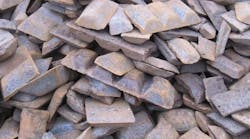Metalcasters must optimize every aspect of their operation in order to remain competitive. No process offers more potential for payback than recovering metallics from scrap — materials that otherwise would be discarded, at substantial cost. General Kinematics' latest dross-recovery systems “liberate” valuable materials from the waste stream, using vibratory or rotary technology, depending upon the application.
For rotary applications, the Ducta-Sprue® dross reclamation mill liberates precious metals from slag and dross, quickly recovering valuable material. The rotary action imparts significant impact energy to abrade material and break apart slag, dross, and coke from recoverable metals. Continuous screening eliminates the “cushion” of fines, to put more energy into breaking down material. Ducta-Sprue utilizes GK’s patent-pending rotary drum liner system, eliminating the maintenance expense and safety concerns present with other cast liner systems.
As an alternative, the Vibra-Drum vibratory drum is able to be run in either a continuous or batch process, and uses GK’s automated retention system to optimize processing. The Vibra- Drum’s optional lifting mechanism allows the drum to clean-out quickly when running in batch mode, but also allows productretention time when running in a continuous flow. Combining these two variables allows for maximum flexibility, efficiency, and product mix.
The Vibra-Drum excels at separating products by the action the drum creates within the product. The natural-frequency vibration produces a beneficial rotary-like tumbling motion with the addition of vibration, agitation, abrading, and scrubbing to the product, for complete and continuous reduction of material. By virtue of the increased attrition within the bed of the drum, and the resulting generation of heat, material with moisture content may be handled more effectively than conventional or static methods of screening.
No matter which method is used, recovering once-discarded good material from your product waste stream will positively benefit your bottom line. Systems like these can quickly help recover those materials, and help you realize raw materials savings.
Thomas P. Musschoot is the director of R&D/Marketing for General Kinematics Corp.








